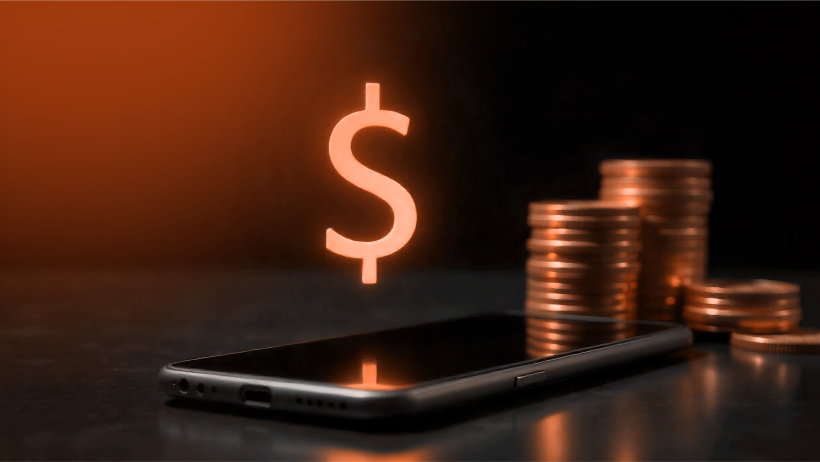Creating a high-performance and user-friendly mobile app is only half the battle. If it’s aimed at a wide audience, you’ll need to figure out how to build a revenue system that will be effective for at least several years to come. Below, we, as a company specializing in the development of mobile software and its subsequent support, will explain how to monetize a mobile app in 2025, and which models will be able to remain profitable for a long time.
Core Monetization Models in 2025

In 2025, basic app monetization strategies transformed to meet new user habits and market demands. If earlier, it was possible to follow a single model and simply scale it over time, today, each of them works only when fully consistent with the context of software use and reaches the highest efficiency in combination with others. So, let's take a closer look at these models:
- Freemium. The free version should be functional enough to retain users, leaving a feeling of missing value. For example, in our experience, the best results come from scenarios where limitations are built into the depth of use rather than into the basic functionality.
- Paid download. When comparing freemium vs paid apps, the second model only works well in highly specialized applications where the value is obvious before downloading (and users aren’t ready to experiment with free alternatives). In particular, this usually applies to the B2B segment, where it’s easier to pay once for a proven solution than to depend on a subscription.
- Subscription. Users are tired of regular monthly payments, which has led to an increase in demand for micro-subscriptions and dynamic tariffs. Moreover, it makes sense to consider flexible models with weekly access, payments for specific features, or corporate packages with payment based on the number of employees.
- In-app purchases. Users don’t want to buy random features – they are much more likely to pay for improving their experience. This could be a unique AI module in an educational app, an extended analytical report in a business tool, etc. The main challenge is that the value of this type of purchase should be felt instantly, and the higher the delay between payment and the result, the lower the conversion will be in the end.
- Ad-supported apps. Banners and pop-ups often spoil retention metrics, so they need to be natively integrated into the product mechanics. For example, these could be product recommendations based on previous purchases and search history, sponsored content, or dynamically selected offers. As for WEZOM, when implementing this model, we build algorithms that take into account the behavior of a specific user so that advertising content looks like part of the user's path.
If you are considering these app monetization models for implementation in your product, you can safely delegate this task to us.
Choosing the Right Strategy for Your App
The right choice of monetization model starts with understanding the business goals, because the way the app generates income should be considered at the MVP stage to ensure consistency of its functionality, UX, and economics.
An equally important aspect is the size and type of the target audience – for example, advertising and microtransactions work better for mobile apps with a wide audience, while a subscription or license is more justified in niche B2B solutions.
Another factor to consider is the type of app (utility, content, service, etc.), since it sets the monetization limitations. For utilities, subscriptions or one-time payments for downloads are most often chosen, while content platforms are built around advertising and microsubscriptions. As for service apps, they often require combined solutions.
Finally, monetization depends on how often and deeply the user returns to the app. If sessions are short but regular, there’s sense in monetization through advertising and micropayments. However, if the interaction is long-term and complex, it will be better to consider a subscription model or a SaaS approach built around a well-structured SaaS revenue model.
Hybrid Models — Combining Monetization Streams
Hybrid models allow businesses to build a “monetization ladder”: for example, by providing free access (for engagement), then displaying ads (to generate minimal revenue from apps), and, finally, offering micro-subscriptions for mass upgrades and/or premium packages for the most valuable audience.
More precisely, you should consider combinations of Freemium+Ads+Micro-subscription and Paid download+In-app purchases for niche solutions, while for monetization for B2B apps, it makes sense to resort to Subscription+API model as a starting option. In any case, you should think carefully about how to correctly integrate these combinations into the user path.
And yes, monetization without considering the UX level most often fails. In particular, too frequent ads negatively affect retention, and, therefore, potential revenue. In general, it’s ideal when the user feels progress, and each paid feature “opens” a new level of experience.
Monetization for B2B vs B2C Apps
In the B2C segment, scalability is a must-have: that is, you must offer the lowest possible price that will be covered by a large number of users. At the same time, B2B customers are willing to pay more if the mobile application can guarantee an increase in their business processes’ efficiency. Therefore, approaches to implementing monetization in both cases are fundamentally different: for B2C, a mass funnel is more effective, while for B2B, it’s better to offer individual contracts and licensing.
By the way, in corporate solutions, licensing and SaaS subscriptions provide excellent income, since their value is measured primarily through ROI for their businesses and not in usability. It’s important that the license includes service support and customization for the client's processes. Also, as an additional source of income in B2B, you can consider custom modifications – for example, integration with ERP/CRM systems and analytic/compliance modules, as well as the implementation of role-based access.
Finally, we often face the fact that clients underestimate APIs and data monetization (ethical), although, in practice, these are one of the best ways to monetize apps, as many companies are ready to pay for access to your algorithms, integrations, or anonymized information.

UX Tips for Increasing Revenue
Monetization is always closely connected with UX, because if users feel uncomfortable, they will simply leave you. That’s why it’s crucial to correctly place paid elements – for example, the price should appear at the moment when the value of the purchase has already become obvious, and where the user is already engaged.
For example, in educational software, demonstrating the price after completing a free lesson works great, while in fitness apps, it’s better to show it after completing a workout. Such a context-dependent trigger increases the likelihood of payment almost twice as much as the classic purchase screen at the entrance.
It’s also worth saying a few words about trial-to-subscription flows – they are effective only if users are engaged from the first day. Actually, that’s why many teams mistakenly open up full functionality for a trial period and then hope that users will want to stay with them on a paid basis. In fact, it’s much more correct to open some of the functions at the very beginning and reveal the value of others in stages, during the trial. This forms a habit and a feeling of incompleteness, which, in turn, significantly increases the number of conversions to subscription.
As for churn, its high values are most often associated not with incorrect pricing, but with the fact that users don’t understand what they are paying for. Therefore, we usually integrate “value confirmation” mechanics, like weekly reports, personalized recommendations, push notifications about the progress achieved, etc.
Metrics to Track App Monetization Success

Without analytics, it’s impossible to understand which channel brings in the most revenue and which is idle. Here are the main metrics that we use to assess the success of the chosen monetization model:
- ARPU (average revenue per user) – essentially, this is a metric that is especially important for mobile apps with advertising and micropayments. At the same time, it’s crucial to take into account not the total ARPU, but ARPU with preliminary segmentation by traffic sources. As for our experience, users from organic channels bring higher ARPU in the long term than in the case of ad-based monetization (even if their conversion is slower).
- Conversion rates – a metric that should be measured both by data from the payment screen and at each step: checking the pricing, clicking the “subscribe” button, completing a transaction, etc. In particular, we always recommend implementing micro-conversions to identify where exactly users get lost and to optimize their progress through the funnel.
- Churn and lifetime value – the second one, LTV, is the main indicator of the long-term app’s sustainability, which, however, doesn’t make sense to take into account without a parallel analysis of the churn rate. For example, a high LTV in one segment can be deceptive if the churn rate in other segments covers the profit. Therefore, it’s much more correct to build analytics on cohort analysis and evaluate how much profit each group of users brings in a certain period.
Of course, this is a basic set of metrics, and ultimately, it can be expanded with more specific ones from project to project. You can contact us to get help with assessing your monetization model’s effectiveness and/or delegate its implementation within the full cycle of mobile development.
App Store Guidelines and Monetization Compliance
Over the past few years, the App Store and Google Play have significantly tightened the transparency requirements for monetization models used by mobile app developers: for example, you can’t hide the price behind additional clicks or introduce a subscription without explicit consent. In particular, we have encountered cases where mobile apps lost months of income due to the incorrect design of pay screens. Therefore, before uploading a mobile app to the app store, we always conduct an audit for compliance with policies.
It’s also worth noting that users become more sensitive to the issue of their personal data privacy. Therefore, even if your monetization model is based on advertising, you still need to figure out how to explain how users’ data will be used and provide a choice to prevent its abuse.
How WEZOM Helps Maximize App Revenue
WEZOM can take on both the technical and visual parts of mobile software implementation, as well as the selection of the optimal business model. In particular, we help our clients determine the monetization strategy at the architecture design stage – this allows us to avoid mistakes when the functionality is ready, but the monetization model doesn’t meet the TA’s specifics.
We also always create the app’s functionality, keeping in mind the expected paid points. For example, for service-oriented applications, we initially ensure the options of flexible subscription and/or upsells within the screen.
Finally, after uploading the mobile application to app stores, we set up an end-to-end analytics system. This gives both our clients and us the opportunity to identify which functions generate revenue and which increase maintenance costs. Ultimately, this information helps us create updates that increase ARPU and retention rates.
Conclusion
Nowadays, a mobile app pricing strategy is much more than a choice between a subscription-based or advertising model. The right approach should always be based on user behavior patterns with their preliminary segmentation, considering hybrid options, and constant analytics. We’re well aware of all these nuances, so you can entrust this task to us – both as part of a full app development cycle and as a separate service.


